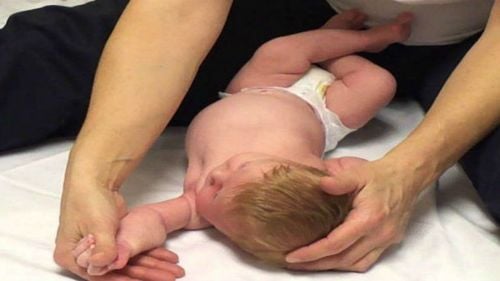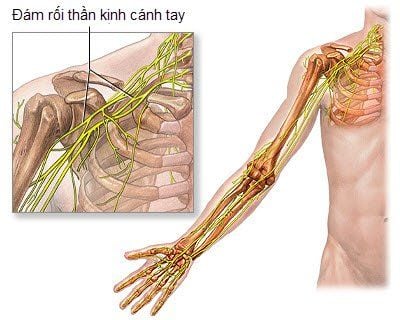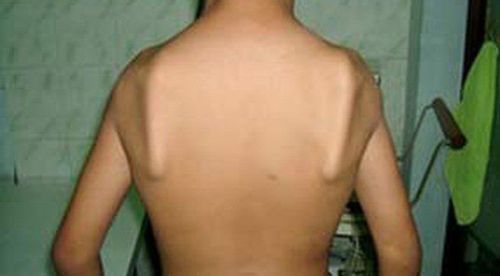This is an automatically translated article.
The article is professionally consulted by Master, Specialist Doctor I Nguyen Thi Thanh Binh - Rehabilitation Doctor - Department of General Surgery - Vinmec Danang International General Hospital.Nerve plexus injury is quite common due to many causes. Children with brachial plexus damage can lead to hand paralysis, sensory disturbances in the upper extremities. Rehabilitation in some cases helps children improve paralysis and limit sclerosis over time.
1. Overview of brachial plexus injury in children
The brachial plexus is made up of nerve fibers that exit from the 5th to 8th cervical spinal cord and 1st thoracic spinal cord. The nerve roots through the vertebral foraminal plexus form nerve roots, which then separate into anterior and posterior branches. Branches join together to form the brachial plexus and from the plexus form nerves. Nerve branches from the nerve plexus will go to the muscles and skin that control movement and sensation for the upper extremities.A nerve plexus injury can affect one or more nerve branches, thereby affecting the motor and sensory functions provided by that nerve.
In young children the cause of damage to the brachial plexus may be during delivery using the procedure or pulling the arm and shoulder during cesarean delivery; or older children are often traumatized in accidents.
Manifestations of brachial plexus injury:
Children have pain and swelling in the soft part of the shoulder and hand on the injured side. Restricted active movement of the upper extremities due to nerve damage of the plexus. Depending on the damaged nerve, the manifestations of motor paralysis vary. If the musculoskeletal nerve is paralyzed, there will be loss of arm movement. Paralysis of the median nerve: Fingers 1 and 2 do not flex when the child makes a fist. Radial nerve paralysis: Loss of ability to extend the metatarsophalangeal joint, restricting the form of the 1st finger. Paralysis of the ulnar nerve: When the hand is clenched, the fingers 4, 5, and part of the 3rd fingers cannot be fully flexed, and the vertebrae cannot be flexed. end of finger 5. Muscles are flabby, muscle tone is reduced. Tendon reflexes on the paralyzed side are reduced compared to the healthy side. Sensory disturbances. In young children, the diagnosis of brachial nerve damage is often more difficult. It is necessary to combine clinical and laboratory manifestations such as CT, MRI and electromyography to assess the extent of damage.
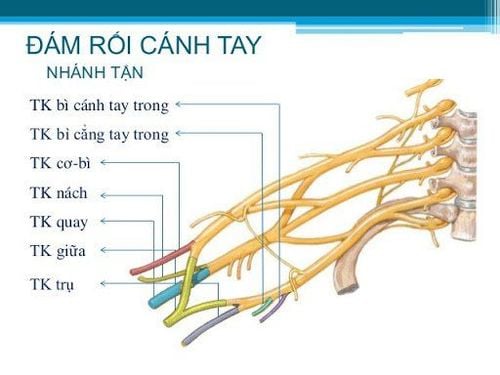
2. Methods of rehabilitation in the treatment of paralysis caused by damage to the brachial plexus
2.1 Purpose of rehabilitation Damaged nerve fibers, if not completely broken, can be restored, but need time and measures to help restore neuromuscular. In the process of waiting for the nerve to recover, if there is no rehabilitation exercise, the muscles and joints of the upper extremities will deteriorate irreversibly. Therefore, it is very important to practice rehabilitation during this time.Exercise helps to increase muscle strength, limit stiffness due to long-term immobility. Limit the situation that the muscles will atrophy, spasm and degrade over time. Using electrical impulses helps stimulate the activity of paralyzed nerves and muscles. 2.2 Rehabilitation methods Massage therapy
Performing muscle massage on the paralyzed arm helps to increase circulation, increase muscle nourishment, reduce spasms, reduce edema and increase muscle strength. Usually, massage is performed before exercise therapy. Gently massage the muscles from the shoulders, arms, forearms, hands and fingers on the side of the paralysis. Therapeutic movement: Includes passive movement to help children limit stiffness and active movement to help strengthen paralyzed muscles.
Principle: During the time when the child still has pain due to injury (about the first 2 weeks), do not intervene. Start doing it after the pain subsides. Passive movement according to the range of motion of the joint: The patient's position is supine. When moving, it is necessary to gently perform all the movements that the shoulder joint can perform and must have full range of motion.
Exercises to flex and extend the shoulder joint: One hand fixes the shoulder joint, the other hand holds the forearm. Slowly bend your arms toward the child's head, then return to the starting position and back.
Form and close, rotate the shoulder joint inward and outward: One hand fixes the shoulder joint. The other hand is held in the forearm. Slowly spread your arms, then return to the starting position and bring them across your chest to the opposite side.
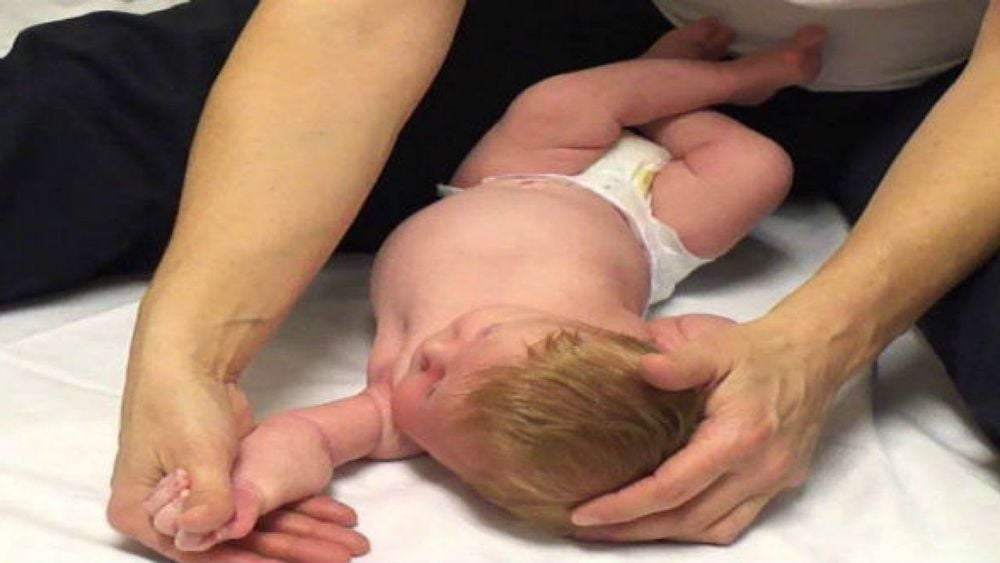
Exercise elbow joint: Keep one hand fixed at the elbow joint. Grasp the hand with the other hand and slowly raise the hand, then turn the hand down again.
Flexing elbows: One hand holds the wrist, the other hand is under the elbow to fix it, then bend the elbow to the maximum, then extend so that the arm and forearm are 180 degrees.
Mobility of the wrist joint
Dorsal flexion of the wrist joint, axial tilt and rotation of the wrist joint: One hand is kept at the wrist joint. Grasp the hand with the other hand and slowly flex and extend the wrist, tilting the wrist left and right.
Mobilize the knuckles
Perform the movements of extending the knuckles, flexing and closing the fingers from the 1st finger
Active movement: Place the child in the mother's lap, facing the KTV. The performer holds the child's healthy hand. Then bring toys with colors and sounds to the paralyzed hand to encourage the child to reach and hold with the paralyzed hand. Active movement helps children practice strengthening their muscles and recovering from paralysis.
Practice correct posture Child sitting: Hanging hands in a position of 90 degree elbow flexion. Children lying down: Lying on their side, paralyzed arms hugging round pillows. Electrotherapy
Uses intermittent low-frequency electrical currents to stimulate the activity of paralyzed muscles. Implementation time: 15-30 minutes / time / day, each session about 15-20 days. Acupuncture
Electroacupuncture can be performed to stimulate muscles and enhance nerve conduction. Acupuncture acupuncture points in the arm, forearm and finger areas of the paralyzed side such as: Kien Ngung, Kien Trinh, Khuc Tri, Thu Tam Ly, Hoc Coc... 2.3 Combined Treatment Methods Combined Rehabilitation With the use of painkillers: Give the child to drink 30 minutes before exercise in case the child has pain due to exercise. Calcium and vitamin D3 help prevent rickets when children are over 3 months old. Surgery: Neurosurgery is indicated in cases of confirmed nerve disruption. However, before surgery, children still need to perform rehabilitation to limit muscle and joint stiffness. In case of ineffective rehabilitation, from 3-5 months, surgery should be considered. The time to perform surgery for optimal results is before 6 months from the time of injury.
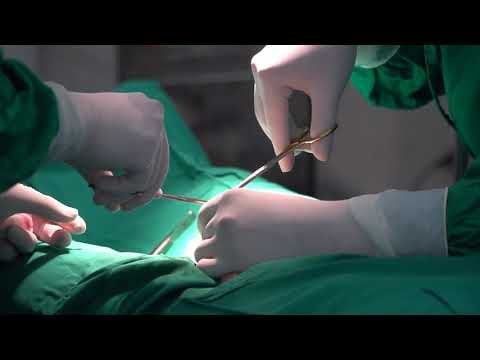
Periodic health check-ups help to detect diseases early, so that there are treatment plans for optimal results. Currently, Vinmec International General Hospital has general health checkup packages suitable for each age, gender and individual needs of customers with a reasonable price policy.
Results of the patient's examination will be returned to the home. After receiving the results of the general health examination, if you detect diseases that require intensive examination and treatment, you can use services from other specialties at the Hospital with quality treatment and services. outstanding customer service.
Please dial HOTLINE for more information or register for an appointment HERE. Download MyVinmec app to make appointments faster and to manage your bookings easily.








